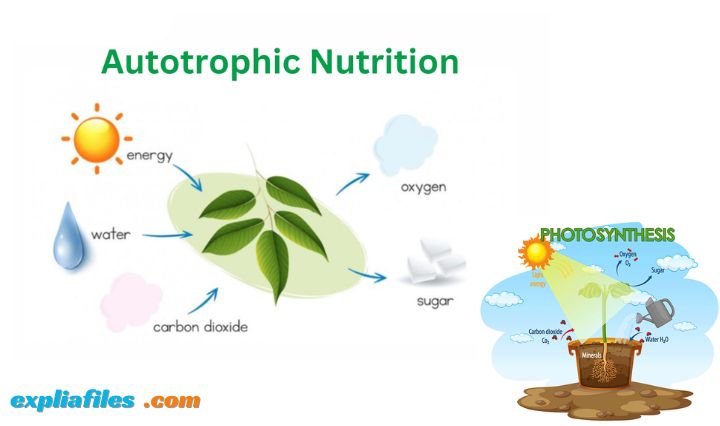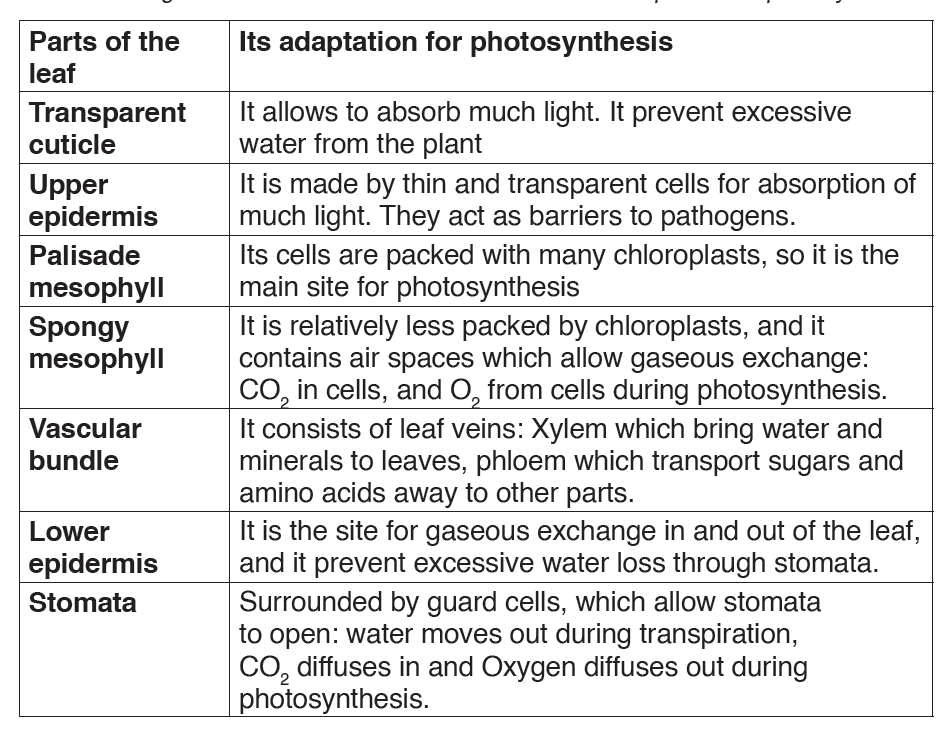Autotrophic nutrition: A cornerstone of life

Autotrophic Nutrition as Photosynthesis is as an energy transfer process, its limiting factors and adaptations.
Introductory Activity
Make a quick lab
Materials: Large clear plastic cup, sodium bicarbonate solution, elodea plant, large test tube.
Procedure:
– Fill a large clear plastic cup with sodium bicarbonate solution (source of CO2)
– Place an elodea plant in a huge take a look at tube with the reduce stem on the bottom. Fill the tube with sodium bicarbonate solution. Caution: hand the test tube carefully.
– Hold your thumb over the mouth of the test tube. Turn the tube over, and decrease it to the lowest of the cup. Make positive there’s no air trapped withinside the tube.
– Place the cup in bright light.
– After at least 20 minutes, look closely at the elodea leaves. Record your observations.
Analyze and conclude:
a) What do you observe on the elodea leaves?
b) What substance accumulated in the leaves? Should the substance be considered as a waste product? Explain.
c) What plant organelle carries out Autotrophic Nutrition and produces the gas? All organisms require macromolecules like carbohydrates, proteins and fat for his or her increase and development. Some organisms produce those natural compounds from inorganic reassets on their very own. Such organisms are known as autotrophs or manufacturers and the method of synthesizing complicated compounds from easy inorganic reassets is known as autotrophic nutrition. While others consisting of people are heterotrophs or consumers, which rely on autotrophs for supply of chemical energy. Green plants are autotrophs and require chlorophyll, sunlight, carbon dioxide, water and minerals for making prepared their very very own food.
Types of autotrophic nutrition
From what you learnt in preceding training approximately plant nutrition, differentiate the varieties of autotrophic nutrition.
Autotrophic nutrition is a process by which living organisms make their own food. This approach is done through manner of manner of photoautotrophs like green plants, green algae and green bacteria; and chemoautotrophs. Living organisms which make their own food are called autotrophs, while others, including humans, which cannot make their own food but depend on autotrophs are called heterotrophs.

There are kinds of autotrophic vitamins including chemoautotrophic and photoautotrophic vitamins.

9.1.1. Chemoautotrophic nutrition
It is an autotrophic nutrients in which organisms (particularly bacteria) get power from oxidation of chemicals, particularly inorganic substances like hydrogen sulphide and ammonia.

Autotrophic nutrition
It is an autotrophic vitamins wherein organisms get electricity from sunlight hours and convert it into sugars. Green plants and some bacteria like green Sulphur bacteria can make their own food from simple inorganic substances by a process called Autotrophic Nutrition. it is a process by which, autotrophs make their own food by using inorganic substances in presence of light energy and chlorophyll. (Green Sulphur bacteria).
Application activity 1
1. Define Photosynthesis
2. Differentiate;
a) Autotrophs and heterotrophs
b) Chemoautotrophs and photoautotrophs.
3. Animals’ life depends on plants. Defend this statement by providing two convincing reasons.
Structure adaptation and role of chloroplast in the process of Autotrophic Nutrition
Activity 2
To show that oxygen is produced during Autotrophic Nutrition
Requirements:
Two large beakers, two funnels (glass), two test tubes, water with sodium hydrogen carbonate dissolved in it, splints, match box, water weed e.g. Elodea or Spirogyra
Procedure 1: Prepare two set-ups of apparatus as shown below.

Note:
Set up A placed in a dark cupboard Set up B placed in a bright sunshine
2. Observe the set-up in the dark cupboard. • What did you notice?
3. Observe the set-up in the bright sunshine. • What do you notice? 4. Test any gas produced using a glowing splint.
Study questions
A) Explain the need of sodium hydrogen carbonate (sodium bicarbonate) dissolved withinside the water?
b) What takes place to the sparkling splint whilst it’s far uncovered to the fueloline withinside the check tubes?
• What is your conclusion from the observation?
c) What was the role of the setup that was placed in the dark cupboard?
d) Name the plant mobileular organelle wherein Autotrophic Nutrition takes place. Plants are autotrophs because they can make their own food by using energy from the sun, carbon dioxide and water as raw materials to make food in a process known as photosynthesis. The chlorophyll comprise via way of means of flowers traps mild power from the sun.
The process of photosynthesis can be summarized as follows:

The chlorophyll arefound in chloroplasts.
Chloroplast is an instance of a plastid. It is the organelle in a plant cell in which Autotrophic Nutrition takes place. Chloroplasts are located withinside the cytoplasm of the cells located in both palisade cells mesophyll, spongy mesophyll and defend cells in a leaf. Cells which have chloroplasts are referred to as photosynthetic cells. To discover whether or not the leaf is the site page for Autotrophic Nutrition, we take a look at for the presence of starch withinside the leaf.
Structure of the chloroplast
Autotrophic Nutrition takes place in chloroplasts which is one of plant cell organelles. A chloroplast contains many sets of disc like sacs called thylakoids, which are arranged in stacks known as grana. Each granum looks like a stack of coins where each coin being a thylakoid. In the thylakoid, proteins are organized with the chlorophyll and other pigments into clusters known as photosystems. The photosystems are the light-collecting units of the chloroplast.
The function of thylakoids is to hold the chlorophyll molecules in a suitable position for trapping the maximum amount of light. A typical chloroplast contains approximatively 60 grana, each consisting of about 50 thylakoids. The space outside the thylakoid membranes are made by watery matrix called stroma. The stroma contains enzymes responsible for Autotrophic Nutrition.

Note: Autotrophic Nutrition prokaryotes have no chloroplasts, but thylakoids often occur as extensions of the plasma membrane and are arranged around the periphery of the prokaryotic cell.
Adaptations for Autotrophic Nutrition
Activity 2.2
Sample a green leaf and analyze its structure. Observe again the illustration showing the internal structure of a leaf to describe the adaptations of the plants and leaf for photosynthesis. By considering both external and internal structures of the leaf, we can recognize several adaptations for photosynthesis.
a) Adaptation of leaf for photosynthesis considering to its internal structure


Note: when stomata are opened, the rate of Autotrophic Nutrition may be 10 to 20 times as fast as the maximum rate of respiration. If the stomata are closed, photosynthesis still can continue, using CO2 produced during cell respiration. The equilibrium can be reached between photosynthesis and cell respiration. Autotrophic Nutrition uses CO2 from respiration, and respiration uses Oxygen from Autotrophic Nutrition. However, the rate of photosynthesis under these circumstances will be much slower than when an external source of CO2 is available. The stomata can’t continue to be closed indefinitely, they should be open so one can hold transpiration of the plant.
b) Adaptation of leaf for Autotrophic Nutrition considering its external structure

– Leaves are thin and flat, this facilitate absorption of the maximum amount of light.
– The cuticle is transparent to allow absorption of light into tissues.
– Presence of a waxy substance on the cuticle to prevent excessive water loss from photosynthetic tissues.
– Presence of the midrib and veins containing vascular tissues like: the Xylem which brings water and minerals from soil to Autotrophic Nutrition
tissues, and Phloem which carry away manufactured organic food from Autotrophic Nutrition tissues to other parts (translocation).
– Having the leaf stalk which holds the lamina in a good position to receive the maximum amount of the light.
2.3. Absorption and action spectra
In addition to water and CO2, Autotrophic Nutrition requires light and chlorophyll. The chlorophyll pigment is found in the chloroplasts. The light that our eyes perceive as white light is a mixture of different wavelengths. Most of them are visible to our eyes and make up the visible spectrum. Our eyes see different wavelengths of visible spectrum as different colours (violet, blue, green, yellow, orange and red) except indigo which is not visible to our eyes. Plants absorb the light energy by using molecules called pigments such as: chlorophyll a, chlorophyll b, carotene (orange), xanthophyll (yellow) and phaeophytin (grey) but chlorophyll a is the principle pigment in Autotrophic Nutrition.
The chlorophyll absorbs light very well in blue-violet and red regions of visible spectrum. However, chlorophyll does not absorb well the green light, instead it allows the green light to be reflected. That is why young leaves and other parts of the plants containing large amount of chlorophyll appear green.

The chlorophyll a as a principle and abundant pigment, it is directly involved in light reactions of Autotrophic Nutrition. Other pigments (chlorophyll b, carotene, xanthophyll and phaeophytin) are accessory pigments. They absorb light colors that chlorophyll a cannot absorb, and this enables plants to capture more energy from light. The amount of energy that the pigment can absorb from the light, depends on its intensity and its wavelengths.
2.4. Calvin cycle and the process of Autotrophic Nutrition in C3 plants
a) Stages and sites of Autotrophic Nutrition in a chloroplast
The process of Autotrophic Nutrition occurs through two main stages such as:
– The light-dependent reactions: which take place in thylakoids, and
– The light-independent reactions (Calvin cycle): which take place in stroma.
Table 9.4: Light-dependent reactions vs The light independent reactions (Calvin cycle)

i. The light-dependent reactions
They require light energy and occur in thylakoids. They produce Oxygen gas and convert ADP and NADP+ into ATP and NADPH.
The light-dependent reactions involve the following steps:
• Photosynthesis starts offevolved while the chlorophyll a in photosystem II absorbs mild at specific wavelengths of mild.
– When the mild power hits the chlorophyll a, the mild power is absorbed through its electrons, through elevating their power level.
– These electrons with high potential energy (electrons with sufficient quantum energy) are passed to the electron-transport chain.
– Excited electrons are taken up by an electron acceptor (NADP+: oxidized Nicotinamide Adenine Dinucleotide Phosphate), and pass along electron transfer chain from photosystem II to the photosystem I. (Note: The photosystems are the light-collecting units of the
chloroplast).
• Enzymes in thylakoids and light absorbed by photosystem II are used to break down a water molecule into energized electrons,
hydrogen ions H+, and Oxygen.

– Oxygen produced is released to be used by living things in respiration.
– Electrons and H+ from photolysis of water are used to reduce NADP+ to NADPH (Reduced Nicotinamide Adenine Dinucleotide Phosphate).
– The light-structured reactions additionally permit era of ATP (Adenosine Triphosphate) through including inorganic phosphate to ADP+ (Adenosine Diphosphate):

Generally, the mild-based reactions use mild energy, ADP, Pi, NADP+ and water to provide ATP, NADPH and Oxygen. Or simply:

Both ATP and NADPH are energy carriers which provide energy to sugars (energy containing sugars) in Light-independent reactions.
ii. The light-independent reactions (Calvin cycle)
The light-independent reactions occur in stroma, and consist of reducing CO2 into sugars by using ATP and NADPH both coming from light-dependent reactions in thylakoids. The Calvin cycle involves three main stages such as:
– Carbon fixation in form of CO2.
– Carbon reduction from CO2 to glucose.
– Regeneration of RuBP.
• Carbon fixation (Carboxylation) in form of CO2
Carboxylation: is the process of fixation of carbon in stable organic intermediate, phosphoglyceric acid.The Calvin cycle begins with a 5-Carbon sugar phosphate called Riburose-1, 5 biphosphate (RuBP) which fixes the CO2 from airThis reaction is
catalyzed by called RuBPcarboxylase-oxygenase (RUBISCO). Rubiscobis-phospahte (RuBP) is the initial acceptor or substrate for dark reaction.

• Carbon reduction from CO2 to glucose
With power from ATP and decreasing energy from NADPH, the phosphoglyceric acid is decreased into 3carbon molecules called glyceraldehyde-3- phosphate or phosphoglyceraldehyde (PGAL). Each molecule of PGA receives an additional phosphate group from ATP, becoming 1, 3-biphosphoglycerate, and a pair of electrons and H+ from NADPH reduces the carboxyl group of 3-phosphoglycerate to the aldehyde group of PGAL which stores more potential energy. ATP gives one phosphate group becoming ADP+, and NADPH gives H+ and electrons to become NADP+.
Both ADP+, and NADP+ will be used again in light-dependent reactions. With 6 turns of Calvin cycle, the plant cell fixes 6CO2 molecules which are used to synthesize 2 molecules of PGAL which leave the cycle and combine to make one molecule of glucose or fructose. This glucose can be converted into:
– Sucrose: when Oxygen combined with fructose. It is a shape through which carbohydrates are transported in plants.
– Polysaccharides like starch for energy storage, and cellulose for structural support.
– Amino acids when combined with nitrates,
– Nucleic acids when Oxygen combined with phosphates, and – Lipids.

• Regeneration of RuBP
The remaining ten 3-carbon molecules (PGAL) are converted back into six 5-carbon molecules, ready to fix other CO2 molecules for the next cycle. The light-independent reactions can be summarized as:


Photorespiration
In most plants, initial fixation of carbon occurs via Rubisco, the Calvin cycle enzyme that adds CO2 to ribulose biphosphate. Such plants are called C3 plants because the first organic product is a three carbon organic compound, PGA. These plants produce less food when their stomata close on hot and dry days. The declining level of CO2 in the leaf starves the Calvin cycle. Making matter worse, Rubisco can accept O2 in place of CO2.
As O2 concentration overtakes CO2 concentration within the air space, Rubisco adds O2 instead of CO2. The product splits and one piece, a two-carbon compound is exported from the chloroplast. Mitochondria then break the two-carbon molecule into CO2. The process is called photorespiration because it occurs in presence of light (photo) and consumes O2(respiration). However, unlike normal cellular respiration, photorespiration generates no ATP, and unlikephotosynthesis, photorespiration generates no food. In fact, photorespiration decreases photosynthetic output by using material from the Calvin cycle.
3 Rate of Autotrophic Nutrition: limiting factors of Autotrophic Nutrition and importance of autotrophic nutrition.
External factors that affect Autotrophic Nutrition
Activity 3.1.
Aim: To show effect of carbon dioxide on the rate of Autotrophic Nutrition.
Materials Required: Elodea, beaker, NaHCO3, lamp.
Procedure: Place a pond weed Elodea upside in a test tube containing water at 25°C. Place the tube in a beaker of fresh water. Place excess sodium bicarbonate (NaHCO3) in the water to give a constant saturated solution of CO2. Place the lamp at a fixed distance from the plant. Maintain the room temperature at 20°C. Count the number of oxygen bubbles given off by the plant in a one minute period.
Observation: The bubbles are formed of oxygen.
Discussion: Discuss why was NaHCO3 added to water.
1. CO2 concentration: Carbon dioxide is the inorganic substrate for Autotrophic Nutrition. Increase in concentration up to 0.05% in atmosphere can cause an increase in CO2 fixation. Carbon dioxide is the major limiting factor, especially in C-3 plants; C-4 plants are more productive even at low concentration of CO2.
Nevertheless, both C-3 and C-4 plants show increase in rate of photosynthesis at high CO2 concentration and high light intensities. The fact that C-3 plants respond to higher CO2 concentration by showing increased rates of photosynthesis leading to higher productivity has been used for some green house crops such as tomatoes and bell pepper. They are allowed to grow in carbon dioxide enriched atmosphere as in glasshouses leading to higher yields.

2. Light: Light is an important factor to carry out photosynthesis. It is rarely a limiting factor in nature as photosynthesis can occur even at low light intensities. There is a direct relation between light and CO2 fixation. With increase in light intensity the rate of photosynthesis increases. However, at higher light intensities, rate does not increase
linearly but light saturation occurs. At very excessive mild intensity, there’s breakdown of chlorophyll molecules referred to as photo-oxidation and the charge of photosynthesis decreases. The first-rate of mild and time of publicity additionally governs Autotrophic Nutrition. Green plants show high rate of photosynthesis at red and blue light.
Light intensity

3. Temperature: The dark reactions are dependent on temperature as they are enzymatic. Rate of Autotrophic Nutrition is best at optimum temperature. Different plants have exceptional temperature optima that still depend upon their habitats.

1. Water: Only about 1% of water absorbed by plants is used in photosynthesis. It is an vital aspect for diverse metabolic procedures in plant. Water may not have direct affect on Autotrophic Nutrition even though it is one of the reactants in light reaction. In water stress plants wilt and their stomata close. Thus reducing availability of carbon dioxide and decreasing the rate of photosynthesis. Water stress will also alter the hydration of enzymatic proteins, affecting their activities.
2. Oxygen concentration: Atmospheric oxygen content affects Autotrophic Nutrition directly or indirectly. The decrease in rate of respiration at high oxygen concentration was first observed by O. Warburg in 1920 in Chlorella. The phenomenon is called Warburg effect.
3. Chemical pollutants: Plant growth has been adversely affected by accumulation of various undesirable chemicals. Heavy metals together with lead, mercury, cadmium appear to be affecting photosynthesis thru stomata closure. Air pollution like SO2, NO2 and O3 also are regarded to have an effect on Autotrophic Nutrition at better concentrations.
Internal Factors
1. Adaptation of leaf: Leaves are arranged on plants to minimize overlapping. The shape, size, age and orientation of leaf influences the absorption of light and thus effects Autotrophic Nutrition. Most leaves are broad for more absorption of light. The anatomy of leaf is also highly specialized for absorption of light. The epidermis is transparent and also acts as convex lens to focus and intensify light reaching mesophyll cells for maximum absorption.
Read about passive income source.




